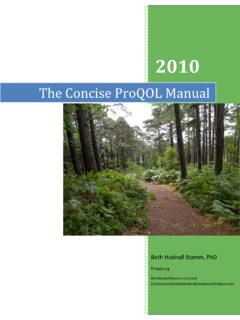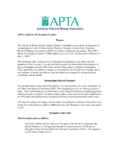Transcription of ZAZEN PRACTICE A GUIDELINE FOR BEGINNERS
1 ZAZEN PRACTICEA GUIDELINE FOR BEGINNERS the fire of emptiness blazes out his beardZAZEN PRACTICE2A Note to Readers:From May, 1999 to the present day, I have had many opportunities to talk to about fivehundred persons who are interested in learning and practicing what the Buddha and Zenmasters teach, and given answers to their questions about Buddhism and Zen on thiswebsite [ ] on daily saw the need for an introductory GUIDELINE on ZAZEN PRACTICE that would , I have tried to put some words down here as a GUIDELINE for those who wouldlike to see into their own nature or Buddha-nature, to free themselves from sufferingcaused by our own greed, anger, and ignorance, and would provide a guide to practicingthe very first he or she would like to help others wanting to achieve the same things, these guidelineswill allow them to do this.
2 Actually, most of what I put them together here already appearin the answers mentioned I put down in these guidelines , in the main part, I received from my own Zenteacher Thong Lac, under whom I practiced, and by his compassion and skillfulteachings, my mind s eye opens at some degree. I deeply bow my thanks to him was about twenty-five years ago and I have kept doing it by myself so far. The otherpart I have gleaned from different books on Zen and ZAZEN PRACTICE by other Zen teachersof both old and recent times, and also from the Buddhist Scriptures (Sutras and Sastras).So, it might be said that nothing here is my you already see, this GUIDELINE may be described as, Scratching the surface. Therefore, it may be revised and added as and when needed. Any comments orsuggestions from anyone of you will be welcomed and appreciated.
3 You can forwardthem to me with the E-mail address below. Thank you in , I would like to deeply say thanks to my friends John Charlson ( ), Joeri Vanden Broeck (Belgium), each of them with great heartedness and talent, helping in editingmy English. All of these make this guide easier to read, understand, and PRACTICE to ourreaders. And I also deeply thanks to all the authors, the translators, and the editors of thesources that I quote and cite in this PRACTICE3MY DEAR FRIEND:BEFORE YOU CONTINUE TO READ WHAT ISPOSTED BELOW. PLEASE ASK YOURSELF: WHAT DO I REALLY WANT IN MY LIFE, PRACTICE AND ENLIGHTENMENT? IF YOUR ANSWER IS YES. JUST KEEPGOING ON. IF IT IS NO. PLEASEDISREGARD PRACTICE4 Bodhidharma (ca. 470 - 543?)Founder of Zen Buddhism. Not establishing words and letters,Teachings transmitted outside the pointing to humans mind,To see into their own natureand attain the Buddhahood.
4 Master Thong Lac (photo 1985)1. What is ZAZEN ? ZAZEN PRACTICE5 ZAZEN is a romanized Japanese term. Za literally means to sit or sitting; zen means to meditate or concentrate. Actually, ZAZEN is much morethan sitting in meditation . In short, ZAZEN is a Buddhist PRACTICE to settleyour mind in its original state: purity and clarity, and from that you can seeeverything in the world as it is. Zen is a Japanese pronunciation for the Chinese word Ch an , and Ch an is in turn a Chinese pronunciation of the word Dhyana in Sanskritor Jhana in Pali, the two ancient forms of the language used in India, in thetime of the Buddha, more than 2,500 years was also known as Yoga , another Sanskrit term, which is a method ofmental PRACTICE used by Brahmins before the time of the , Dhyana is a PRACTICE for settling the mind, which is usuallywandering around at all time and leads us into confusion state.
5 However, Ch an or Zen is something more than meditation or concentration. Itcombines the threefold PRACTICE of Bodhisattva s Way:Observing Sila (Precepts)Developing Samadhi (Power of Mind Focusing)Practicing Prajna (Wisdom). Zen is not simply a device for centering and calming the mind but alsoembracing the wisdom of also recognize the five different types of Zen. In his Ch an-yuan-chu-ch uan-chi , a collection of sayings of Chinese Ch an masters and briefhistories of various Ch an sects, Tsung-mi (780-841), a Ch an master andHua-yen patriarch, listed the five different types of Zen as follows:(1) non-Buddhist zen: for example: the zen practiced in other religions thanBuddhism like Brahmanism, Hinduism, Jainism, Confucianism, (2) Ordinary zen: the zen as in haiku poems, William Blake s poems, HenryD. Thoreau s (3) Hinayana Zen: the zen which a Buddhist Elder practices to attainsainthood, often for the practitioner PRACTICE6(4) Mahayana Zen: the zen which a Bodhisattva (a candidate ofBuddhahood) practices to attain enlightenment not only for himself but alsofor others.
6 (5) The last one is the Zen of the Highest Vehicle. It emphasizes on thequality and the characteristics of enlightenment achieved through the type ofzen PRACTICE and the degree of wisdom embraced in that enlightenment. Itincludes the Zen of the Tagathatas and the Zen of the Patriarchs, the Zenof the highest quality of wisdom emanating from the highest asked about what is the difference between the Zen of the Tagathatasand the Zen of the Patriarchs, a Zen master replied: Mountain is blue; snow is white. For me, I would say: The white cloud covering the snow mountain, theircolors are not the same. 2. Purposes in ZAZEN :In his Zen Fables for Today , Richards McLean retells the following story: Why must I meditate in order to achieve enlightenment? demanded theprince of the teacher. I can study, I can pray. I can think on issues this silly emptying of mind?
7 I will show you, said the teacher, taking a bucket of water into the gardenunder the full moon. Now I stir the surface and what do you see? Ribbons of light, answered the prince. Now wait, said the teachersetting the bucket teacher and boy watched the calming surface of the water in thebamboo bucket for many minutes. Now what do you see? asked theteacher. The moon, replied the prince. So, too, young master, the only way to grasp enlightenment is through acalm and settled mind. This simple story is telling us the purpose and the way of ZAZEN very PRACTICE ZAZEN is to see into one s own nature or Buddha-nature,which is from the very beginning, pure and calm, and every being in theworld has PRACTICE7 This is what the Buddha declared when he had just attained his SupremeEnlightenment and was recorded in the Avatamsaka-sutra (The FlowerOrnament Scripture) and repeated in the you see into your own nature, you know who you are, you know whatand how every thing and being in the world really is.
8 From this, your actionand reaction will be in harmony with the whole and in situations around have some words for you that will help you avoid the following situation:You may have already heard someone who has misunderstood or mistakenthe declaration of the Buddha about the Buddha-nature, and said: We all areBuddhas, we are already , we do not need to PRACTICE zazenat all. This person might think himself or herself already enlightened, does notpractice ZAZEN , and indulges in many wrong things which he or she doesn words would be correct for anyone who already sees into his or herown nature, knows where it is, and what it looks anyone who does not yet see into his or her own nature, does not knowwhere it is, what it looks like, and cannot prove this through his or her ownexperience of awakening before a real Zen teacher, then he or she is not anenlightened one.
9 They just speak about something borrowed from theBuddha or a Zen master, not of his or her own experience of is considered the biggest type of zen-sickness. Words and experienceare not in , there are people who did not have any experience of enlightenmentbut often criticized others: You are attaching to enlightenment! or You areclinging to detachment! when they heard someone said something aboutenlightenment or detachment. This is even more ridiculous than the ones whothought that I am already a Buddha or I am already enlightened, becausethey do not know what the true enlightenment is or what the real detachment is also called a zen-sickness of words and action do not match each PRACTICE8In case you really think you are an awakened one, test yourself with thesequestions:Master Yueh of Toushuai set up three barriers to question students:Crossing rivers and passing through mountains to learn and search out thehidden, is only for seeing into the own-nature.
10 Right now, where is yourown nature?Only when you know your own-nature then you can be freed from birth anddeath. When you are dying,, how will you be free?When you are freed from birth and death, then you will know where you arefrom and going to. When the four elements [which composed your body]disintegrate, where do you go? 1 Your answers should come out directly and spontaneously from your kenshoand need the approval of a real Zen teacher. If not so, you need to putyourself into ZAZEN PRACTICE until you are able to do so. Sit yourself like theBuddha did for six years long in the forests and 49 days and nights under theSala tree at Bodh-gaya. Sit yourself like Bodhidharma did facing to the bluerock-wall for nine years long at the Shao-lin Monastery in Sung-shanMountain in yourself like the Sit yourself like 1 (from Wu-men Kuan by Zen master Wu-men, the 47th koan, translated fromChinese text).






